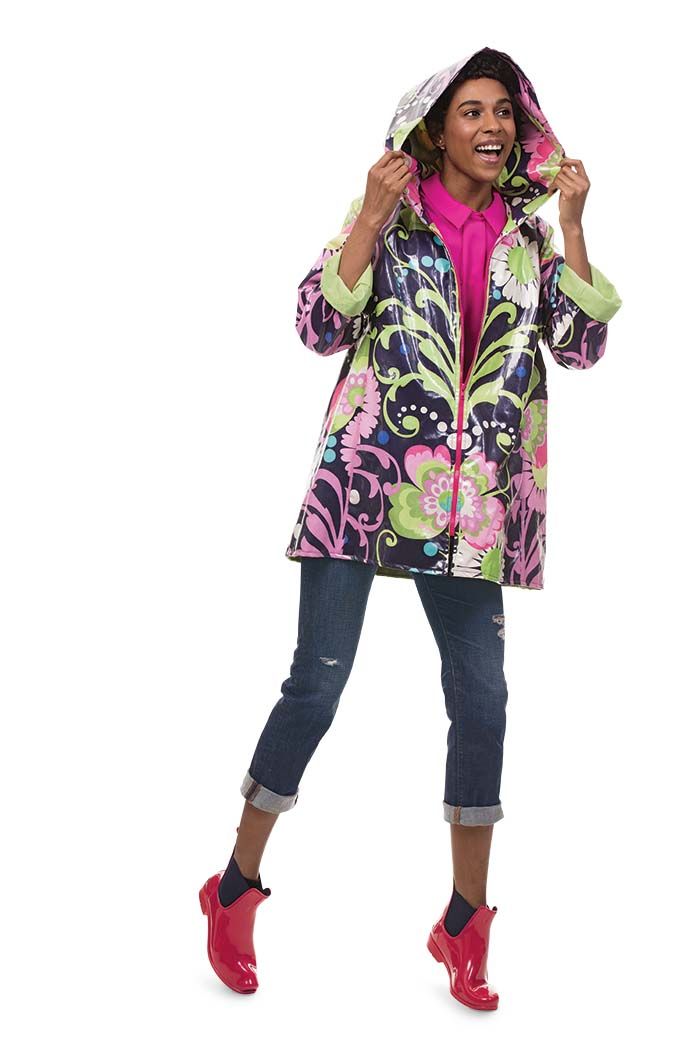How to Sew Laminated Cotton
Water rolls off this utilitarian yet fun fabric
Laminated cotton, a fairly new arrival to the sewing world, uses lamination technology to turn a fabric workhorse—plain-weave cotton—into a water-resistant jewel. It is lighter and has more drape than oilcloth and performance fabrics like Gore-Tex, and it’s available in cheerful prints.
The fabric is created by fusing a lightweight polyurethane laminate sheet to a cotton fabric’s right side. The laminate typically extends across the fabric width (though in some instances it stops about an inch from the selvage), and the resulting textile can be up to 60 inches wide. Store your laminated cotton rolled on a tube to avoid creases, which may be tricky to press out.
For small projects, you can create laminated fabric (even double-sided) up to 18 inches wide, by fusing purchased laminate with your iron. The finished product might not be as smooth or permanent as manufactured laminated cotton, however, because a home iron doesn’t achieve the same even, firm pressure as industrial equipment.

Use laminated cotton for any project that would benefit from a wipe-clean, water-resistant finish. Polyurethane laminates (as opposed to vinyl-coated “oilcloth”) are approved for use in infants and children’s products by the Consumer Product Safety Improvement Act, so you can feel comfortable using them for kids and adults. Raincoats and hats, umbrellas, tote bags, lunch bags, travel pouches, aprons, shower caps, baby accessories, and more can be practical, playful, and stylish when sewn in this multipurpose textile.
Cutting guidelines
Follow these guidelines for problem-free pattern and fabric preparation.
• Choose patterns with few shaping seams that can be constructed entirely by machine.
• Layout patterns in a single layer using full, rather than half, pattern pieces.
• Use pattern weights to anchor pattern pieces when planning the layout.
• Cut with sharp shears or rotary cutters with clean blades.
Sewing advice
This stable fabric isn’t difficult to handle if you try some of these tools and techniques.
• Choose a medium-size universal or Microtex needle; size 80/12 works well.
• Stitch with polyester thread, which does not deteriorate when exposed to regular wet or dry conditions.
• Reduce pressure on the presser foot if possible, or raise and lower the foot every few inches to allow the fabric to settle.
• Install a Teflon or walking foot to make sewing smoother and to reduce ripples.
• Set the machine for a medium-length stitch to minimize holes that may weaken the seamlines.
• Pin inside the seam allowance only with fine, glass-head pins, or use clips to secure layers temporarily.
• Opt for sew-in cotton interfacing if needed; the laminated fabric can’t withstand the heat needed to firmly apply a fusible.
• Make samples to test machine settings.
Pressing and finishing tips
High-heat pressing and elaborate seam finishes may weaken the fabric. Here are some alternative methods.
• Pink or topstitch seam allowances if the garment is unlined. The fabric won’t ravel, but topstitching helps keep seam allowances flat and edges crisp.
• Finger-press the seams to test fit or seam shaping before permanently creasing the fabric.
• Press lightly on the wrong side with a cool iron and press cloth to avoid melting the laminate coating.
• Apply a seam sealant for greater water resistance.































Sounds like a great idea! Where can I find this fabric?
There are suppliers online--do a Google search on "laminated cotton" and you'll find online retailers as well as Etsy shops that carry this.
Carol Fresia
Threads Senior Technical Editor
How stiff is it?
Shirley, it depends. some are heavy and best for things like outdoor tablecloths. Others are quite supply and are used for baby bibs, diaper covers, sandwich wraps, and so forth. These would work well for raincoats, too. You may want to order a swatch to feel the weight.
Carol Fresia
Threads Senior Technical Editor
Thank You!
Thanks for posting. I'm definitely going to look into this.